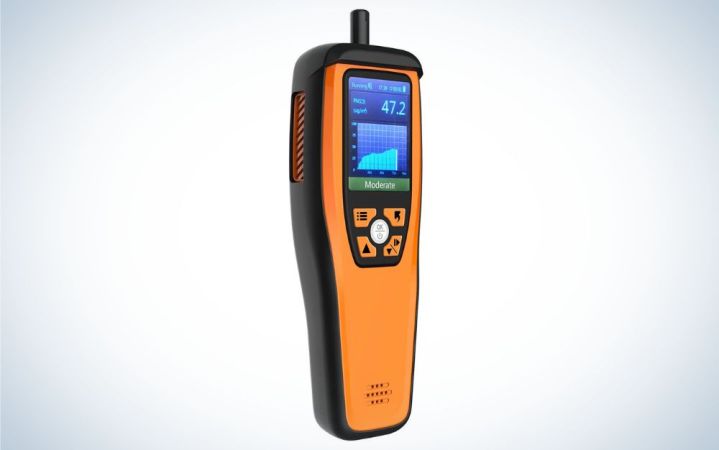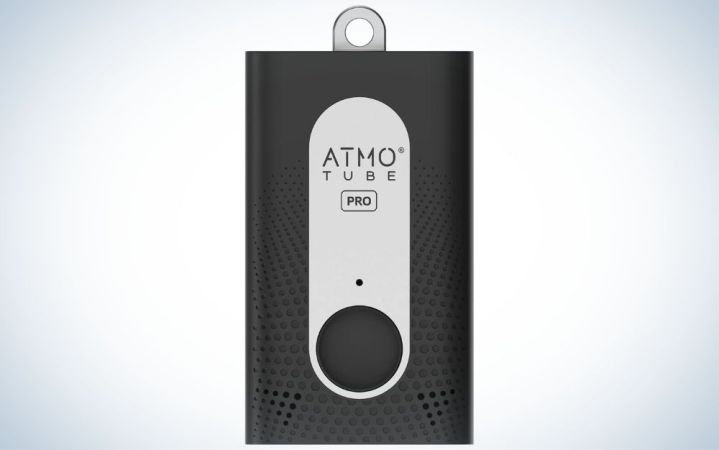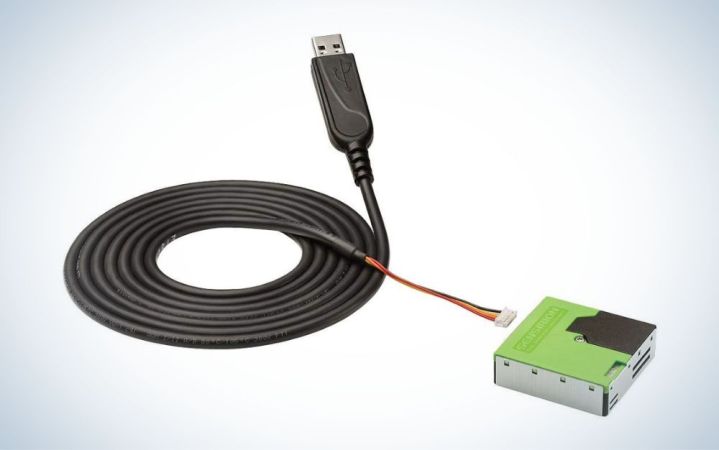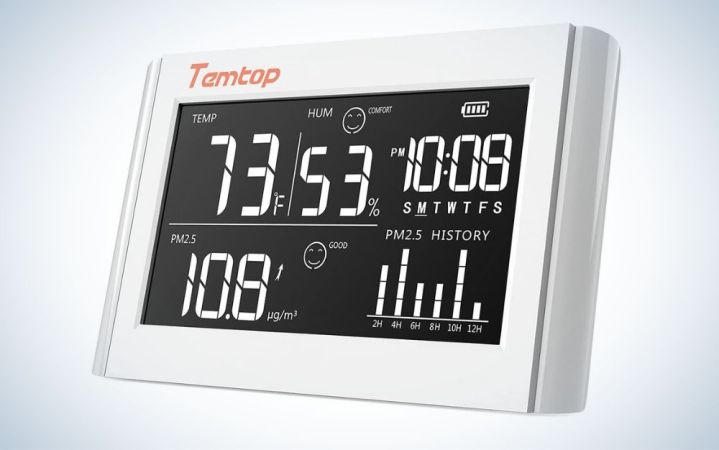Nothing beats a breath of fresh air, but air can be contaminated by chemicals, soot, wildfire smoke, and other forest fire byproducts, making an air quality monitor a valuable tool. Even those with the best noses can have difficulty telling how good their local air is, especially with odorless gasses and “Volatile Organic Compounds” (VOCs) from products or processes lurking, so what are you to do? You could call in an air quality professional … or you can begin to do your own tracking with our best overall pick, the Temtop M2000 2nd, or one of our other picks for best air quality monitors.
- Best overall: Temtop M2000 2nd
- Best smart: Atmotube Pro Portable
- Best indoor/outdoor: Davis Instruments AirLink
- Best portable: Sensirion SPS30
- Best value: Temtop P20
How we chose the best air quality monitors
Largely, selecting the best air quality monitors was more a matter of hitting the research shelves than the shopping cart button. With such a product, the customer sentiment and manufacturer-supplied specs really mean a lot less than in-depth product analysis from researchers and experts who were able to compare consumer-facing products with laboratory-grade equipment. This results in a thin product selection, but I was able to identify five air quality monitors that I can confidently recommend.
The best air quality monitors: Reviews & Recommendations
What is the best air quality monitor? The best air quality monitors have been tested from official sources and come in various shapes, styles, and working methods. While the Temtop M2000 2nd Generation is the top pick for air quality monitors due to its ease of use and robust testing ability, our four other monitors might be right for you, depending on your circumstances. In any event, these five air quality monitors have both proper testing and current availability in the market.
Best overall: Temtop M2000 2nd Generation
Why it made the cut: The Temtop M2000 2nd Generation tests for a wide variety of pollutants, has built-in calibration, and includes an audible alarm.
Specs
- Measures: CO2, HCHO (formaldehyde), PM2.5/PM10, Temp., Humidity
- AQ-SPEC report: High consistency
- Type: Handheld
Pros
- Tests many things all in one device
- High consistency across many devices
- Has an audible alarm for when levels rise too high
- Tried and tested by several school systems
Cons
- Doesn’t work in temperatures below freezing
The Temtop M2000 2nd Generation is a relatively easily operated handheld air quality monitor that has been widely used. It has been used by the New York State Education Department, and the United Federation of Teachers has used it to measure carbon dioxide levels in schools in efforts to fight COVID-19.
The 2nd Generation product improves upon the original Temtop M2000 by adding a data export feature. This is really useful because, as mentioned by the AQ-SPEC report, where the Temtop M2000 2nd Generation suffers losses in accuracy, it makes up for it with high levels of consistency. Even across multiple Temtops, the reading levels should be consistently similar in the same situation. This means that you can pinpoint exactly when contaminant levels have started rising, even if you have to have a replacement device.
I’m also particularly pleased that it attempts a calibration system. While the accuracy, consistency, and difficulty for average users feel a bit daunting, the system’s overall capabilities are more than enough to begin with. Part of the calibration process being that you leave the device outside for lengthy periods is also annoying but manageable.
In reality, the main concern is the device’s limited capabilities during the colder months. Without being able to function below 32 degrees Fahrenheit, the supposed “indoor-outdoor” nature of the device is cut off for many months of the year for those of us too far North or South of the equator. Luckily, in-home monitoring will still work year-round.
Finally, if you like the look of the M2000 2nd Generation, but are looking for something quite a bit cheaper, our budget choice also comes from Temtop. The Temtop P20 has reduced features but also a reduced price tag.
Best smart: Atmotube Pro Portable
Why it made the cut: The Atmotube Pro attaches directly to your backpack or belt clip and alerts your phone directly when there’s a problem.
Specs
- Measures: PM1/PM2.5/PM10, VOCs, Temp., Humidity, Barometric Pressure
- AQ-SPEC report: High accuracy, high precision
- Type: Wearable
Pros
- Impressive accuracy counts
- Handy app alerts
- Works well across a wide variety of temperatures and humidities
- Keychain size
Cons
- Shorter battery life than hoped for
The Atmotube Pro Portable is a keychain-size air quality monitor that won’t take up much space and can be put just about anywhere or come with you. All of the data collected will be at your fingertips via the Atmo app, available free for Android and iOS devices.
The app will give you your personal stats, access to personal and global maps, and a personalized series of articles to help you understand air quality. You can also export your device’s data as a CSV file for further analysis.
According to the Atmotube’s AQ-SPEC results, the device is quite accurate, ranging from 86% to 98% across various conditions. The AQ-SPEC report also notes that the device is highly consistent across various environmental conditions, saying that heat and humidity had “minimal effect” on the device’s precision. Despite its small size, the Atmotube Pro delivers at a high level.
One of the bigger disappointments with the Atmotube Pro is the battery life. As expected of such a small device, the battery is also quite tiny. When the device is set to take measurements only once every 30 minutes, you can squeeze about a week out of the little battery. However, when you crank that up just a notch, the battery dies much more quickly. This is very unfortunate when using a device that, by its very nature, you want to set up and forget about. Fortunately, if the device isn’t meant to be mobile, you can keep it plugged into the charger while it is running.
Best indoor/outdoor: Davis Instruments AirLink
Why it made the cut: The AirLink is made for both indoor and outdoor usage, provides beautiful charts, and works well with other Davis Instruments systems.
Specs
- Measures: AQI, Temp., Humidity, Dew Point, Heat Index
- AQ-SPEC report: Highly accurate for PM1.0/PM2.5, but not for PM10, consistent
- Type: Indoor or outdoor
Pros
- Weatherlink.com integration
- Easy-to-read graphs and charts
- Installs easily both indoors and out
- Integrates into your Davis weather station
Cons
- Poor PM10 reading
The Davis Instruments AirLink comes with a heavy-duty body that can be conveniently placed in indoor or outdoor environments. If you want it in your house, place the machine on a desk or table. It has four safety feet to reduce the chances of it sliding off smooth surfaces. Alternatively, mount it outside (near an outlet) and attach the provided weather-resistant cover.
If you’re into more than just air quality monitoring, you’ll really appreciate the extra things the AirLink tracks, such as dew point and heat index. You’ll also be happy to note that it will connect with weatherlink.com and can integrate with your other Davis weather station products, justifying its position as the best splurge. These services are also available on your phone via the WeatherLink app.
I really appreciate that the output looks professional but still feels closer to what you might expect from a cable weather station than what your average lab coat wearer would be reading. The only thing I was disappointed with is that, as per the AirLink’s AQ-SPEC report, the PM10 readings weren’t too accurate. Really, though, this is just a small trade-off for a good home system, and typical consumers will be more than happy with this machine.
Best portable: Sensirion SPS30
Why it made the cut: The Sensirion SPS30 is a no-frills machine dedicated to particulate matter testing.
Specs
- Measures: PM1.0/PM2.5/PM4.0/PM10
- AQ-SPEC report: High precision
- Type: Portable
Pros
- Small size
- 8-year lifetime
- Long-term stability and contamination-resistance
- Moddable
Cons
- Drab UI makes interpreting data difficult
If you want to feel like you’re really in the lab, the Sensirion SPS30 might be right up your alley. Right from the moment I opened the company’s product introduction video, I felt instantly reintroduced to the lab environment I once came from.
Where this really shines is the Sensirion SPS30’s great moddability. For example, some users are soldering them on bikes for CanAirIO, a citizen science project dedicated to building a citizen network for monitoring air quality worldwide. The simple USB port connection and loads of data quickly generated by the device lend it to lots of projects. Other possibilities include pairing it with air conditioners, smart home devices, HVAC equipment, and more.
Where this “lab environment feel” really doesn’t shine is the UI. If you’ve ever worked with in-company software or any niche data-collection devices, you probably already know what I mean. You sure get a lot of data, but it isn’t going to look beautiful or come easy to read. Check out the company’s demonstration video for an up-close look at the graphs provided by the machine before deciding whether to purchase.
As for the Sensirion SPS30’s AQ-SPEC report, the key thing to know is that the device is highly precise across temperatures and humidity levels. While PM1.0 and PM2.5 levels were highly accurately measured in field and laboratory testing, PM10 levels were shown to be highly inaccurate in the field trials.
Best value: Temtop P20
Why it made the cut: This solution will take care of all of your basic air quality monitoring needs.
Specs
- Measures: PM2.5, Temp., Humidity
- AQ-SPEC report: Higher precision at low temperatures
- Type: Desktop or mountable
Pros
- Highly accessible interface
- Everything needed for wall mounting included
- Can double as a nice desk or wall clock
- Exportable data
Cons
- Limited pollutants measured, but still great for price
- Low battery life
Considering that a laboratory-grade air quality tester can cost thousands of dollars, it would seem impossible to make a competitive one in the three-digit range. However, with Temtop’s P20, that isn’t true.
The Temtop P20 can measure PM2.5 pollutants. While it’d be nice to measure other pollutants or even other sizes of particulate matter, doing one thing well is quite impressive. The P20’s AQ-SPEC report tells us that the machine’s precision is most accurate when the local temperature is lower. That being said, the measurements indicate an accuracy of over 90% for most conditions at 68 degrees Fahrenheit.
You’ll probably enjoy having the Temtop P20 around, as it is also a rather nice LCD screen clock. To take a bit of the mystery out of the reading counts, a cute smiley face interprets the PM2.5 levels as good, fair, or poor. Another smiley face interprets your local humidity levels in a similar manner.
While the device can be mounted on the wall and includes the screws needed to do so, I recommend using the back stand and using it as a desk monitor. On the wall, the numbers, time, and smiley faces will probably prove somewhat tricky to see clearly. This will also help you keep it plugged into a charger because the battery only lasts for about 6-8 hours on a single charge.
Finally, those of you interested in data will rejoice. Much like the Temtop M2000 2nd Generation, our top choice of air quality monitor, the Temtop P20 has USB connectivity to export the collected data in CSV format.
What to consider when buying the best air quality monitors
One thing to note from the current research is that air quality monitors for public usage are still an emerging market. As such, there are a lot of claims about accuracy that are either demonstrably false or haven’t been thoroughly checked by scientists or any actual regulatory board. With all of this in mind, here are the key things to remember when buying an air quality monitor:
Target pollutant
In a fantasy world, an air quality monitor could sniff out any potential harm in the air and let you know. Unfortunately, air quality monitors in the real world must be designed to target specific contaminants. While it is never a mystery what pollutants an air quality monitor tracks—as they are nearly always prominently displayed in the specs and ads—you may find yourself overwhelmed with a few new terms. Here’s a quick mini-guide to get you up to speed on air pollution vocab:
- PM: PM stands for “particulate matter,” and measurements of it can tell you how many liquid or solid particles of varying sizes are in your air. The particles are measured in microns, given after the “PM.” For example, PM2.5 tests for the amount of particles that are approximately 2.5 microns in your air. The makers of the Atmotube report that PM1 particles are typically emissions from factories and vehicles, PM2.5 particles usually come from fires and combustion, and PM10 particles are from pollen, mold, and fine bits of old plants and insects. You’ll find that PM2.5 is a common measurement taken by portable air purifiers.
- AQI: This stands for Air Quality Index and is a popular but somewhat outdated method for measuring air quality. Essentially, the AQI measures pollutant levels for a wide variety of substances, gives them each a score from 0-500, and reports the highest one. It doesn’t matter if only one pollutant is high or if several are, only the top one is getting reported. Still, the data is historically known and the conversions for each pollutant can still be useful. If you want to play around with the system, a handy AQI calculator is available for you.
- VOCs: These are “Volatile Organic Compounds” and largely come from human sources. The EPA warns that sources of these contaminants include household cleaners, building materials, and standard office equipment. They also have found that these pollutants are consistently found in much higher concentrations in indoor settings. VOCs are a big part of why our recommended floor cleaners focused so heavily on ingredients. Certain high-end air purifiers, such as the Dyson Purifier Humidify+Cool Formaldehyde, are specifically equipped with sensors attuned to these byproducts we bring into our homes as we upgrade furnishings and electronics, etc.
Scientific usage
Before making any purchase of something as important as an air quality monitor, be sure to check out how the product is perceived by experts. That can be as simple as running a Google search with “site:.edu” or “site:.gov” followed by the product name or trawling through the depths of the “Air Quality Sensor Performance Evaluation Center” (AQ-SPEC) website.
AQ-SPEC provides comprehensive data on air sensors after real-world field trials. While AQ-SPEC reports explicitly state that they are not an endorsement of a particular monitor, the evaluations are free for the manufacturer if the sensors are “low-cost” and meet basic selection criteria. As a result, simply bothering to submit a sensor for an AQ-SPEC report is a sign of a manufacturer’s good faith in their product.
All of the air quality monitors on our list have a detailed AQ-SPEC report. Unfortunately, these reports can be a bit dense and read more like a Ph.D. journal submission than a consumer-facing report. I’ve attempted to condense these reports down into the relevant bits, but if you’ve got any interest, you’re highly encouraged to parse through them yourself as well.
Accuracy & consistency
Accuracy and consistency feel very similar at a glance but affect our perceptions of an air quality monitor in big ways. As you might be able to gather from a recent analysis by the Berkeley Lab, accuracy is going to be difficult to maintain. However, high consistency will make these machines still quite valuable sources of information for your home.
Part of this comes down to calibration, which laboratory equipment undergoes frequently. Take the humble pH machine, for example. Back in my lab days, I remember calibrating this machine nearly every day I would use it, using specialized liquid solutions. Now imagine calibrating something that measures air … at home. It appears that cheap calibration is on the way, but that doesn’t necessarily mean it will be easy or reliably done by the average person.
The result is that we have to expect some loss of accuracy when high-quality calibration isn’t feasible. Depending on what is being measured, this might not necessarily be too much of a problem. For example, your home thermometer is likely about 1 degree off, but it is still enough to tell you that you have a fever. The key is getting something accurate enough for your purposes.
Perhaps more important is consistency. While several consumer-grade air quality monitors have a bias, especially after being run for multiple days, if that bias is consistent, we can still get extremely useful information. For example, if your reading for Carbon Dioxide suddenly skyrockets above what you are used to getting, you know you have a problem.
FAQs
Air quality monitors can cost anywhere from around $80 to a few hundred dollars. Depending on their specifications, laboratory-grade air quality monitors can cost over $2,000 and quickly get into the several-thousand-dollar range. Routine maintenance and calibration can also become regular expenses for these high-level machines. Fortunately, our selection of the best air quality monitors has been tested against these professional machines and fares relatively well.
An air quality monitor can be a mold detector but won’t be able to tell you that you have mold. Molds are typically detected by PM10 sensors, as are other particulate matters, like pollen. So, an air quality monitor that can test for PM10 particles will be able to detect mold particles in your air but not tell you that those particles are mold.
The best way to monitor air quality in dusty industrial rooms is to get your dust problem under control quickly. When you can see you have a problem with air quality, you are less in need of an air quality monitor and more in need of an air purifier.
You should place it where you spend the most time, or the place you’re most concerned about, e.g., a child’s bedroom. Air quality monitors should be placed at breathing height, which is 3-6 feet above the ground. Keep them away from air pollution sources, like toasters, to get a more accurate reading.
Final thoughts on the best air quality monitors
- Best overall: Temtop M2000 2nd
- Best smart: Atmotube Pro Portable
- Best indoor/outdoor: Davis Instruments AirLink
- Best portable: Sensirion SPS30
- Best value: Temtop P20
Getting a high-quality air quality monitor doesn’t have to be for laboratory professionals alone. While the world of personal air quality monitoring is still emerging, there are still some great products out there. Combining the most stringent testing circumstances with ready commercial availability produced a list of exactly these five air quality monitors, so we’re sure customers will find satisfaction from something on this list.
Why trust us
Popular Science started writing about technology more than 150 years ago. There was no such thing as “gadget writing” when we published our first issue in 1872, but if there was, our mission to demystify the world of innovation for everyday readers means we would have been all over it. Here in the present, PopSci is fully committed to helping readers navigate the increasingly intimidating array of devices on the market right now.
Our writers and editors have combined decades of experience covering and reviewing consumer electronics. We each have our own obsessive specialties—from high-end audio to video games to cameras and beyond—but when we’re reviewing devices outside of our immediate wheelhouses, we do our best to seek out trustworthy voices and opinions to help guide people to the very best recommendations. We know we don’t know everything, but we’re excited to live through the analysis paralysis that internet shopping can spur so readers don’t have to.
The post The best air quality monitors for 2024 appeared first on Popular Science.
from Popular Science https://ift.tt/rf5QL7R









0 Comments